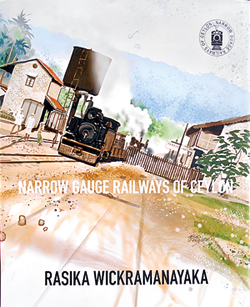Chugging to life a vanished rail heritage

A1330 NG rail car: Watercolour by Sisara Liyana Arachchi
In this magnificent hard cover volume with 450 pages of text, timetables, maps and over 200 rare photographs, Rasika Wickramanayaka has captured the essence of the railways that played an important part in the development of this country.
A chartered architect and certified project manager by profession, Rasika Wickramanayaka (born in 1978) has drawn on his life-long fascination with this country’s Narrow Gauge railways, locomotives and rolling stock to produce this unique book. It is a comprehensive and amazing celebration of the recently lost past, when bucolic Ceylon was being transformed into modern Sri Lanka.
The Narrow Gauge (2ft 6in) Uda Pussellawa Railway (UPR) and the Kelani Valley (KV) Railway with its Yatiyantota, Ratnapura and Pelmadulla extensions, were introduced to provide transportation in areas unsuitable for the wider Broad Gauge (5ft 6in) railway.
In the 1940s and 1970s, these Narrow Gauge lines were closed, except for the KV Line from Maradana to Avissawella.
This extraordinary book is a work of pure passion and dedication. It is remarkable what the author’s research over a period of 15 years has uncovered and revealed here for posterity. Every reader interested in Sri Lanka’s, alas vanished, rail heritage will experience a frisson of delight just at the sight of this beautifully produced and painstakingly detailed book.
Ceylon Government Railways operated 115 miles (186km) of Narrow Gauge railways by 1919, comprising the Uda Pussellawa Narrow Gauge Railway which reached the highest altitude of any railway in the country at Kandapola Station (6,316 feet) and the Kelani Valley Railway.

Hunslet No. 221, Kottawa Station 1976
Each chapter in the book begins with a summary of its topics. In Chapter 2 the UPR is discussed in detail, even quoting the wages of its staff. At its peak, 16 trains a day ran on the line, mostly carrying plantation produce and supplies. Although it ran through impressive scenery that could have made it a tourist attraction and was known as “the world’s most picturesque stretch of railway,” it was closed in 1948.
The backstory of the KV Line is interwoven with the history of planters’ agitation for a railway. Construction began in 1908, with an extension reaching Opanayake in 1919. The steam locomotives and rail cars used on the line are listed. This Narrow Gauge railway was gradually reduced until 1991when the track was converted to Broad Gauge with an additional outside rail.
Here I must declare an interest since I am part of the story. I was the only passenger on the last Narrow Gauge steam-hauled passenger train making the journey on the KV line from Maradana to Nugegoda on Friday, October 25, 1991. The single wooden carriage was hauled by a venerable Hunslett steam locomotive Class J1A, number 220, built in 1924, driver C.F.E. Hewapanne. This was followed by a diesel powered, gaily decorated, new, orange and grey liveried Broad Gauge Hitachi suburban unit, number 826, driver S. K. Alahappruge. This ceremonial procession of Narrow and Broad Gauge trains on the same railway commemorated the conversion of the last Narrow Gauge railway in Sri Lanka to Broad Gauge.
 This amazing book might have ended with that conversion but there are 400 more pages of arcane facts and figures, as well as intriguing insights into the past. For instance, who knows now that there was once a siding for 2ft Narrow Gauge Simplex Diesel locomotives serving Mantai Salterns at the Elephant Pass Railway Station? It was part of the country’s industrial Narrow Gauge railways (of varying gauges) that were built to aid irrigation and other construction works.
This amazing book might have ended with that conversion but there are 400 more pages of arcane facts and figures, as well as intriguing insights into the past. For instance, who knows now that there was once a siding for 2ft Narrow Gauge Simplex Diesel locomotives serving Mantai Salterns at the Elephant Pass Railway Station? It was part of the country’s industrial Narrow Gauge railways (of varying gauges) that were built to aid irrigation and other construction works.
Details of all NG locomotives, the gauge, wheel arrangement, builder, builder’s number, year and number of locomotives are shown in charts. Carriages and wagons, including painting and varnishing, are listed, together with a description of the liveries of rolling stock.
The third chapter is dedicated to the memories of the bygone railway glory of the Ratnapura district. There is an intriguing reference to the KV train being known as the “love train” due to its use by couples wanting privacy on the move as there was no vestibule connection between the carriages. Another revealing comment captures the tone and time of the KV line: “The carriages smelled of processed rubber sheets, cinnamon and pepper and it was common to see passengers with their gem mining equipment.”
Chapter Four consists of the author’s discussion of the aftermath of the KV Railway and covers the Broad Gauge conversion as well as “mysteries and myths” and the preservation of BG and NG rolling stock in railway museums. Topics covered in Chapter Five include eyewitness accounts of NG travel as well as a useful NG timeline. Appendices feature 44 pages of timetables, details of steam locomotives and passenger carriages as well as drawings and facts about the bridges and culverts of the Ratnapura and Pelmadulla extensions, with photos. There is also an appendix dedicated to track gradients and station layouts and one of miscellaneous technical details.
This is not a coffee table book, even though it is so lavishly produced. It is a reference book to treasure and then pass on to the next generation. As it is a limited edition of 500 copies, each one numbered, it will surely become a valuable collector’s item.
(The book priced at Rs. 8,500 can be ordered from: rasikabookz@gmail.com)


